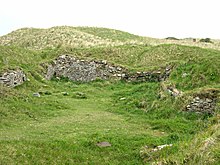St Piran's Oratory
The buried by Sandflug St Piran's Oratory (English St Piran's Lost Oratory ) at Perran Bay in Cornwall is one of the most important early Christian sites in England and Great Britain . It was supposedly built by St. Piran in the 8th century and consists of a rectangular nave and a choir, possibly separated by a wooden rood screen . The entrances are to the south and east. The southern one, with an archway with three carved heads, probably dates from the 17th century. A stone bench runs around the interior. A stone with a Latin inscription in a nearby wall may indicate earlier activities in this place.
After it was placed under protection in 1835, the stone carvings around the door were stolen and in 1910 a concrete bunker was built above the oratory to protect against sand drift. During the 20th century, increasing vandalism and environmental problems led in 1980 to the decision to give up the space that is now under the dunes. In 2014, however, a new excavation was decided and started.
The cemetery connected to the chapel is also under the quicksand and human bones are regularly blown out. A woman with a child in her arms was discovered near the chapel entrance along with other bodies in the early 20th century. All were (according to Christian rite) oriented east-west, but buried with crossed legs. Twelve stone boxes made of slate with human bones were discovered in 1980. With the cemetery, the foundation walls of a possible baptistery, which could still be identified in the early 20th century, are buried under the dunes.
The later church "St Piran an den Perran Sands" was built around 1150 when the chapel was increasingly silted up. It was expanded in the 15th century and abandoned in 1804 because of sand flights. Near the church stood St Piran's cross, possibly referred to as "cristelmael" in a document from 960 AD. The entire place is enclosed by an earth wall and possibly represents an early church enclosure or a monastic "Lann". It is possible that the enclosure called "Gear" (fortified settlement) is an Iron Age complex left to St Piran . The exact location of the settlement Lanpiran, recorded in the Domesday Book of 1086, is unknown, originally the place of the oratory was held for it. A series of investigations outside of the enclosure revealed small remains of other buildings. So a hamlet could have been here. The traces of an early medieval field system in the vicinity could also be connected to the church.
literature
- R. Cole: Gear Sands, Perranzabuloe. An Archaeological Assessment. Historic Environment Service, Cornwall County Council 1997.
- Homer Sykes: Mysterious Britain - Fact and Folklore George Weidenfeld & Nicolson Ltd. 1993 ISBN 0-297-83196-8 p. 69
Web links
Coordinates: 50 ° 21 '57.1 " N , 5 ° 8' 2.8" W.

